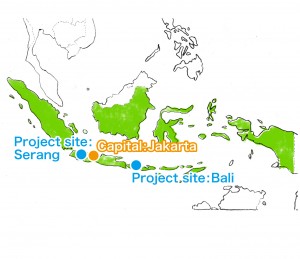 Aiming at improvement of maternal and child health in rural areas of Serang Regency, Banten Province, PHJ has been extending maternal and child health care education and required skill training to health center midwives, traditional birth attendants and health volunteers of villages. Having accomplished the initial targets, PHJ transferred its projects to the local organizations and closed its office in December 2016. PHJ extends its sincere appreciation to all the supporters for their support of its Indonesia projects and operations up to now.
Aiming at improvement of maternal and child health in rural areas of Serang Regency, Banten Province, PHJ has been extending maternal and child health care education and required skill training to health center midwives, traditional birth attendants and health volunteers of villages. Having accomplished the initial targets, PHJ transferred its projects to the local organizations and closed its office in December 2016. PHJ extends its sincere appreciation to all the supporters for their support of its Indonesia projects and operations up to now.
Indonesia
 Indonesia is a country that stretches over the equator and spreads to about 5,000 km both to the west and east, consisting of more than 14,000 islands. Due to this diversity, Indonesia is a multiracial state, each island having specific dishes and customs. About 90% of the population believe Islam and this religion bundles the nation’s conciousness. Regarding sightseeing, Indonesia has the famous resorts like Bali and so the country is familiar to the Japanese people. Although the country overcame the economic crisis of 1997, a big earthquake and “tsunami” disaster hit Aceh and other parts of Sumatra island in 2004. The country has felt the impact of the economic crisis of 2008 but thanks to the government’s financial stability program and economic stimulation programs, supported by active domestic consumption, the country has maintained relatively high growth rate. Indonesia is a country of many possibilities
Indonesia is a country that stretches over the equator and spreads to about 5,000 km both to the west and east, consisting of more than 14,000 islands. Due to this diversity, Indonesia is a multiracial state, each island having specific dishes and customs. About 90% of the population believe Islam and this religion bundles the nation’s conciousness. Regarding sightseeing, Indonesia has the famous resorts like Bali and so the country is familiar to the Japanese people. Although the country overcame the economic crisis of 1997, a big earthquake and “tsunami” disaster hit Aceh and other parts of Sumatra island in 2004. The country has felt the impact of the economic crisis of 2008 but thanks to the government’s financial stability program and economic stimulation programs, supported by active domestic consumption, the country has maintained relatively high growth rate. Indonesia is a country of many possibilities
Introduction of Projects
Maternal and Child Health Improvement (2004~2016) more
Nutrition Improvement Education (2003~2016) more
Past projects more
Country Information
| Indonesia | Japan | |
|---|---|---|
| Area | 1,890,000 sq. km | 378,000 sq. km |
| Population | 258 million | 127 million |
| Gross national income per capita | US$ 3,630 | US$ 42,000 |
| Ethnic groups | Majority is Malays (Javanese, Sundanese, and other 27 groups) | Japanese 98.5%, Ainu, Korean, Chinese |
| Official language | Indonesian (Bahasa Indonesia), 400 regional languages | Japanese |
| Religion | Muslim 88.1%, Christian 9.3%, Hindu 1.8%, Buddhist 0.1% | Shinto + Buddhist 84%, Christian 2%, Others 7.8% |
| Life expectancy | 69 years | 84 years |
| Fertility rate | 2.4 children born/woman | 1.4 children born/woman |
| Literacy | 93% | 99% |
| Infant mortality rate | 23/1000 live births | 2 / 1000 live births |
| Under 5 mortality rate | 27/1000 | 3 /1000 |
| Percentage of 1 year-olds fully immunized against measles | 77% | 98% |
| Maternal mortality rate | 126 persons / 100,000 | 5 persons / 100,000 |
| Skilled attendant at delivery |
87% | 100% |
| HIV/AIDS prevalence rate(15-49 years) | 0.2% | Not available |
Source:UNICEF 2016, MOFA Japan 2016
